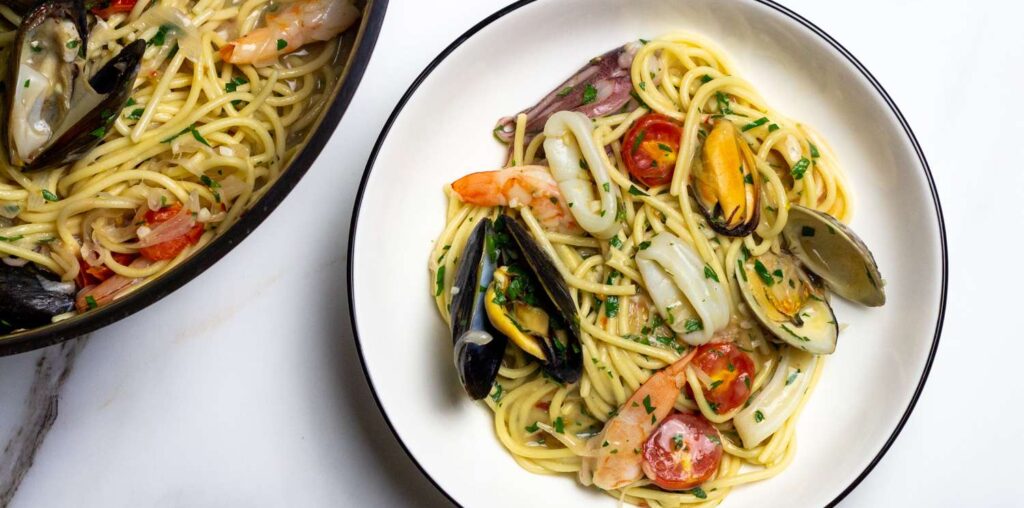Why It Works
- Cooking the seafood in stages ensures that all of the components are at their textural best in the final dish.
- Cooking the pasta risotto-style, a technique known as spaghetti risottati, means the spaghetti absorbs the flavor from the shellfish broth.
- Bottled clam juice intensifies the natural flavor of the steamed shellfish.
Spaghetti allo scoglio is found all over coastal Italy, and it’s prized for its mix of fresh seafood, which can include clams, mussels, shrimp, and cuttlefish or squid. Like spaghetti alle vongole, scoglio isn’t saucy; instead it consists of long strands of al dente pasta with a silky coating packed with briny seafood flavor, thanks to the combination of fresh shellfish liquor, acidic white wine, a touch of fresh tomato, and peppery olive oil.
I live on Martha’s Vineyard, so the seafood available to me is categorically different than the delicate, iridescent frutti di mare of the rocky Adriatic coast. The clams are larger and their shells thicker, the shrimp are shipped frozen from Florida, and the squid isn’t nearly as tender as the seppia (cuttlefish) found in Puglia, where I first tasted pasta allo scoglio.
The key to the dish is getting the spaghetti to absorb the flavorful broth released by the shellfish. Sure, you can achieve this by boiling the pasta first and then finishing it in the skillet with the seafood. But my friend Daniela, chef and co-owner of Le Macàre, showed me a better way when I visited her in the Salento, Puglia’s southern sub-peninsula, a few years back.
She made the dish with spaghetti risottati, or spaghetti prepared risotto-syle, the dry pasta cooking directly in the skillet with the shellfish, so that it absorbs the liquor from the clams and mussels as they steam open.
The results were stunning, with each strand of pasta infused with sapore di mare (the flavor of the sea). To successfully adapt my friend Daniela’s scoglio method for this recipe, I knew I had to cook the various seafood in stages to ensure that everything was just cooked through at the time of serving. Different types of seafood cook at different rates, so I start off by steaming the clams and mussels with aromatics and white wine, just until they open up and release their flavorful liquor. I take the shellfish out of the pan, and I supplement the briny broth left behind with bottled clam juice and a little water, which I then use as the cooking liquid for the pasta. Once the mixture comes to a boil, I add the spaghetti.
While I wait for the spaghetti to cook, I shuck the meat from half of the clams and mussels. While Daniel correctly observed in his spaghetti alle vongole recipe that digging through a pile of shells isn’t the best dining experience, for this dish you have to keep some of the shells for presentation, otherwise it just isn’t scoglio. (“Scoglio” translates to “reef.”)
Once the pasta is cooked “al chiodo” (to the nail)—a few minutes shy of al dente, just beginning to soften on the exterior, but uncooked at the center—I add quick-cooking shrimp, squid, and cherry tomatoes to the mix, tossing and stirring until the shrimp are opaque and the squid pieces are just cooked through. The halved cherry tomatoes will release some of their sweet juices into the sauce, but they’ll still hold their shape (we’re not looking for burst tomatoes in this dish). I add the mussels and clams back to the skillet and toss everything together until all the seafood is heated through and the pasta is al dente, and then serve it immediately.
March 2021
This recipe was cross-tested in 2022 and lightly updated to guarantee best results. To help the tomatoes hold their shape better, we now incorporate them into the pasta mixture further along in the cooking process.

